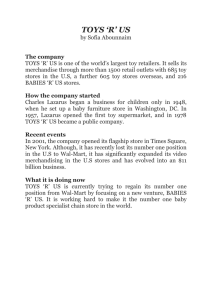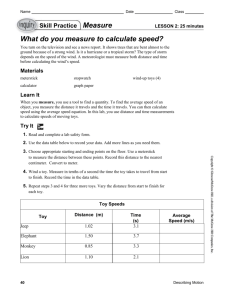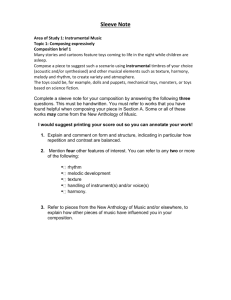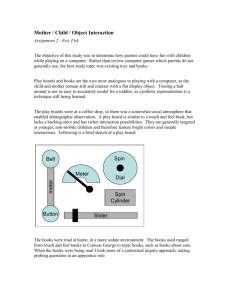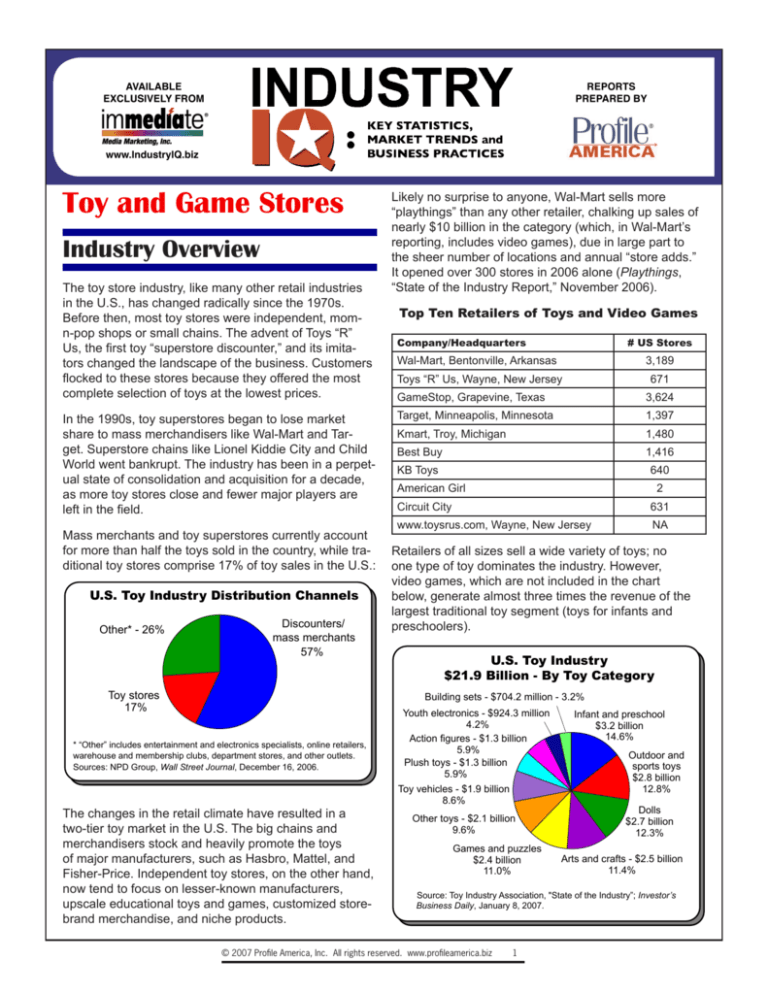
Toy and Game Stores
Industry Overview
The toy store industry, like many other retail industries
in the U.S., has changed radically since the 1970s.
Before then, most toy stores were independent, momn-pop shops or small chains. The advent of Toys “R”
Us, the first toy “superstore discounter,” and its imitators changed the landscape of the business. Customers
flocked to these stores because they offered the most
complete selection of toys at the lowest prices.
In the 1990s, toy superstores began to lose market
share to mass merchandisers like Wal-Mart and Target. Superstore chains like Lionel Kiddie City and Child
World went bankrupt. The industry has been in a perpetual state of consolidation and acquisition for a decade,
as more toy stores close and fewer major players are
left in the field.
Mass merchants and toy superstores currently account
for more than half the toys sold in the country, while traditional toy stores comprise 17% of toy sales in the U.S.:
U.S. Toy Industry Distribution Channels
Other* - 26%
Discounters/
mass merchants
57%
Toy stores
17%
Likely no surprise to anyone, Wal-Mart sells more
“playthings” than any other retailer, chalking up sales of
nearly $10 billion in the category (which, in Wal-Mart’s
reporting, includes video games), due in large part to
the sheer number of locations and annual “store adds.”
It opened over 300 stores in 2006 alone (Playthings,
“State of the Industry Report,” November 2006).
Top Ten Retailers of Toys and Video Games
Company/Headquarters
# US Stores
Wal-Mart, Bentonville, Arkansas
3,189
Toys “R” Us, Wayne, New Jersey
671
GameStop, Grapevine, Texas
3,624
Target, Minneapolis, Minnesota
1,397
Kmart, Troy, Michigan
1,480
Best Buy
1,416
KB Toys
640
American Girl
2
Circuit City
631
www.toysrus.com, Wayne, New Jersey
NA
Retailers of all sizes sell a wide variety of toys; no
one type of toy dominates the industry. However,
video games, which are not included in the chart
below, generate almost three times the revenue of the
largest traditional toy segment (toys for infants and
preschoolers).
U.S. Toy Industry
$21.9 Billion - By Toy Category
Building sets - $704.2 million - 3.2%
* “Other” includes entertainment and electronics specialists, online retailers,
warehouse and membership clubs, department stores, and other outlets.
Sources: NPD Group, Wall Street Journal, December 16, 2006.
The changes in the retail climate have resulted in a
two-tier toy market in the U.S. The big chains and
merchandisers stock and heavily promote the toys
of major manufacturers, such as Hasbro, Mattel, and
Fisher-Price. Independent toy stores, on the other hand,
now tend to focus on lesser-known manufacturers,
upscale educational toys and games, customized storebrand merchandise, and niche products.
Youth electronics - $924.3 million
4.2%
Action figures - $1.3 billion
5.9%
Plush toys - $1.3 billion
5.9%
Toy vehicles - $1.9 billion
8.6%
Other toys - $2.1 billion
9.6%
Games and puzzles
$2.4 billion
11.0%
Infant and preschool
$3.2 billion
14.6%
Outdoor and
sports toys
$2.8 billion
12.8%
Dolls
$2.7 billion
12.3%
Arts and crafts - $2.5 billion
11.4%
Source: Toy Industry Association, "State of the Industry”; Investor’s
Business Daily, January 8, 2007.
© 2007 Profile America, Inc. All rights reserved. www.profileamerica.biz
Issues and Trends
The rising popularity of home video games has
had an undeniable impact on the toy store industry.
Many traditional toy stores were initially reluctant to
stock video game hardware, as the profit margin is
considerably lower than for traditional toys. But the
enormous demand for these products inspired toy
stores, particularly the larger stores, to reluctantly
embrace them. An estimated $10 billion is spent by
U.S. households on video games, and the category is
growing by around 6% annually, according to the Toy
Industry Association.
As recently as the early 2000s, many toy stores began
stocking fewer traditional toys and more video games,
to satisfy the nearly half of U.S. children who start on
video games at 4 to 5 years of age (Time magazine,
December 2004). But while the video game category
continues to generate a lot of attention and revenue,
traditional toys are poised to make a comeback, after
dropping by around 3% in 2005 and 2006.
With the growing number of children in the preschool
age group, and with many parents looking for more
“balance in the toybox,” traditional toys that encourage
creativity are rebounding (Investor’s Business Daily,
January 8, 2007). That trend will benefit high-end
specialty retailers (like F.A.O. Schwarz), which typically
emphasize unique, ornate, handcrafted, and exclusive
toys (Wall Street Journal, December 16, 2006).
The biggest category winners of late have been youth
electronics, which refers not to video games but instead
to educational DVDs for preschoolers -- like Baby
Einstein and its new rival Little Steps -- as well as Digital
Song and Story Player from Fisher-Price, VCamNow
(a video recorder), and the Kid-Tough Digital Camera.
Suffering the biggest losses have been action figures
and accessories, as well as stuffed animals (“plush”):
Toy Supercategories: Winners and Losers
Youth electronics
Vehicles
Building sets
Arts and crafts
-3%
-3%
-3%
-5%
- 9%
-13%
-15%
-15
4%
2%
0
1
2
3
4
5
6
10
15
20
25
Toy Industry Trends and Forecasts
•
Despite all the hype generated by video games,
traditional toys still occupy more of kids’ playtime.
A study conducted by NPD Group in the Fall of
2006 reported that children spend about 9% of their
free time playing with traditional toys, compared to
6% with video games and other electronic items.
Traditional toys also typically enjoy higher profit
margins than video games.
•
The trend toward “more active parenting” will help
drive sales of traditional toys. As parents look for
more ways to engage with their children and spend
quality time together, they’ll turn to construction
blocks, art materials and crafts. These toys are
also desirable because they are simple to use:
parents open a box and are able to immediately
sit on the floor with their children and play -- with
no need to read operating instructions or technical
specifications, or assemble sophisticated products.
•
Another reason parents are returning to traditional
toys is to encourage social interaction. Unlike
digital technology, which promotes a solitary
pattern of play, traditional toys also encourage kids
to develop math skills and creativity.
6%
Source: U. S. Cenusu Bureau
5
According to a review of several articles about the toy
industry, there may just be reason to celebrate in 2007.
Target Market Population Growth Projections
9 to 12
0
U.S. toy producers and retailers have struggled for years
with price competition, kids’ changing toy preferences,
and escalating operating costs (driven by high energy
costs, increasing interest rates, and the growing costs
of marketing and advertising). Industry participants of all
stripes are ready for a few good years.
Stability, if not growth, should return to the industry if
for no other reason than the population of children is
expected to grow. Consider the chart that follows, which
indicates that the preschool set (age five and younger)
is expected to increase by 6% between 2005 and 2010,
outpacing growth of other age groups.
6 to 8
-5
Source: Playthings, “State of the Industry,” November 2006.
Around 62% of industry revenue is generated by toys
for the 7-and-under set, with the 18-and-older segment
(primarily “gamers”) generating 19%. The remaining two
segments (the 8-to-12 age group and teenagers aged
13 to 17) generate 16% and 3%, respectively, of industry
revenue (Playthings, November 2006).
5 and under
-10
+23%
+8
+3%
0%
Total toy industry
Games and puzzles
Outdoor and sports toys
All other toys
Dolls
Plush
Action figures and accessories
Sources: Investor’s Business Daily, January 8, 2007; New York Times, February 11, 2006; Playthings, January 2007.
© 2007 Profile America, Inc. All rights reserved. www.profileamerica.biz
Differentiation strategies used by many independent
retailers help set them apart from their big-box
competitors. They not only stock unique, hand-crafted
items and educational toys, they also use a variety of
other strategies, including the following:
Independents’ Differentiation Strategies
•
•
•
•
Hosting birthday parties in the store, for a fee
(ranging from an ice-cream treats party for $25
per child, to an all-out all-nighter for thousands).
Creating giant displays of unusual items, especially those that provide some interactivity to more
fully “engage” children (which gives their parents
time to browse through the store).
Offering frequent-buyer loyalty programs to
reward customers, which encourages them to
return (giving a gift or a half-off coupon when
they reach a certain level of spending within a
designated period of time).
Assembling (for a price) toys that consumers
may have purchased at big-box retailers (and
encouraging parents to browse while assembly is
taking place).
While it’s parents who actually pay for toys, the real
decisions about what toys to buy are made by kids.
Producers and retailers alike are in a competitive
contest to win the hearts and minds of youngsters,
so most advertising is geared toward children. And
since online sales of toys are increasing by around
35% annually (Forrester Research, “The 2006
State of Retailing Online”), many retailers are taking
their messages to the Internet, in addition to using
traditional offline advertising vehicles like television
and radio (used largely by national chains), as well as
newspapers, local magazines, Yellow Pages, and direct
mail (used routinely by independents).
Value of Products and
Services in the Industry
Toy costs run the gamut from a $1 bag of marbles to
a $15,000 miniature Mercedes-Benz that travels up
to 15 miles an hour. Average per-visit spending on
toys also varies dramatically, depending on the outlet
where they’re purchased; Wal-Mart or Target items
cost considerably less, on average, than toys at FAO
Schwarz or at specialty toy stores.
Determining average household spending on toys
can help a specialty retailer determine market size
and market share. The industry’s $21.9 billion in retail
revenue translates to average annual household
spending of $195. In an area of 30,000 households, it is
fair to assume that $5.8 million is spent on toys.
If a specialty toy retailer generates revenue of $1 million
annually, his or her market share would be 17%, a
baseline for comparison against future performance.
Typical prices for a variety of popular toys follows:
Brand Name / Type of Toy
Average Price
Atari Flashback
$69.95
Emerson Radio, Spongebob DVD-CD Player
$35.24
Oregon Scientific Smart Globe
$99.99
Playskool Weebles Castle
$39.95
Dora’s Talking Dollhouse
$49.99
Spider-Man, Itsy Bitsy Spider-Man
$24.99
Chatnow Communications 2-Pack
$74.99
Xbox 360 Console
$299.99
Kid-Tough Camera
$65.99
TMX Elmo
$44.99
Critical Success Factors
CSFs For Toy Retailers
•
Hire enthusiastic employees who are customerservice “ambassadors,” and train them to be
knowledgeable enough to help educate parents and
patient enough to guide children in the selection of
age- and personality-appropriate items.
•
Stock a vast array of toys: trendy toys, classic toys,
toys that appeal to every age group, active indoor
toys, and toys that shoppers can feel good about
giving their children and grandchildren.
•
Know the demographics of the area in which the
store is located, and target advertising messages
and promotions accordingly. To neighborhoods
populated primarily by older people, convey “gifts for
grandchildren” messages. In an area populated by
young couples with preschoolers, describe the many
offerings of stimulating educational products.
•
Monitor the competition and stock what they do not,
and become friendly with the service desk folks and
toy department employees at the “big boxes.” Ask
them to refer customers to the store for items they
do not carry. Most will be happy to do so, rather than
sending them to their mass merchant competitors.
•
Rearrange the store and change window displays
frequently, to create awareness of the breadth and
depth of the store’s merchandise.
Sources: Playthings, January 2007; Investor’s Business Daily, January 8,
2007; Wall Street Journal, December 16, 2006; Playthings, November 2005.
Industry Resources
Playthings magazine, www.playthings.com
Toy Industry Association, www.toy-tia.org
The Toy Book, www.toybook.com
© 2007 Profile America, Inc. All rights reserved. www.profileamerica.biz
Background
Values and Benefits
Media Marketing, Inc., creators of imMEDIAte®
software, has been in the forefront of sales
presentation systems since 1987. The imMEDIAte suite, a state-of-the-art consultative
system, is used by hundreds of media reps every day to create compelling presentations
and expert media proposals. Built on Microsoft
Office® technology, the imMEDIAte system
provides a complete solution to your media
sales needs.
Media Marketing is an authorized distributor
of Profile America’s IndustryIQ reports. Sales
and marketing teams embrace these industryknowledge reports because of their concise,
easy-to-read style and rich store of information.
Regular use of IndustryIQ reports creates a
relationship-building, consultative environment. Since 1986, Profile America has provided
profiles of industries, markets and trends to
business-to-business marketers, facilitating
an understanding of the industries into which
they sell their products and services.
Program Objectives
IndustryIQ reports are used by managers
as sales training, planning and business
development tools. Sales reps use IndustryIQ
reports to prepare for sales calls and as a
valuable leave-behind.
Armed with independent, third-party
assessment of industry dynamics, media reps
can “walk the walk and talk the talk” of their
advertisers’ industries, allowing reps to better
assist advertisers in creating compelling,
effective messages for their target audiences.
Sales reps want to be smart about advertisers’
industries, but face the realities of limited time
and resources. They need to track dozens of
different industries, and value these concise,
easy-to-use sales tools that they can leave
behind with their advertisers.
Likewise, managers want reps to be confident,
professional and informed. They want their
reps viewed as partners, not vendors -- and
they appreciate the IndustryIQ method
of collecting, analyzing and presenting
information.
Independent, third-party IndustryIQ reports
leave marketing and sales professionals
free to practice their core competencies:
developing successful advertising strategies
for their clients.
Delivery
IndustryIQ reports incorporate a customer-
guided approach to gathering information
and creating industry-knowledge products.
We value your content recommendations as
we strive to create the most useful, fact-filled
industry reports available.
IndustryIQ reports are available in PDF
format from Media Marketing’s web site,
www.industryIQ.biz.
IndustryIQ is distributed by Media Marketing, Inc., in association with Profile America, Inc., for use by advertising sales representatives.
Although the information in this report has been obtained from sources that Profile America, Inc. believes to be reliable,
no guarantees are made as to the accuracy of the information presented, and any information presented may be incomplete or condensed.
© 2007 Profile America, Inc. All rights reserved. www.profileamerica.biz

